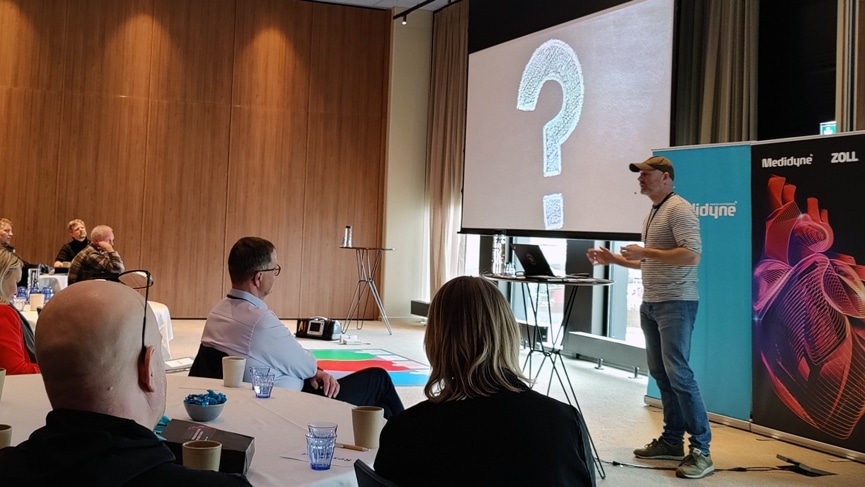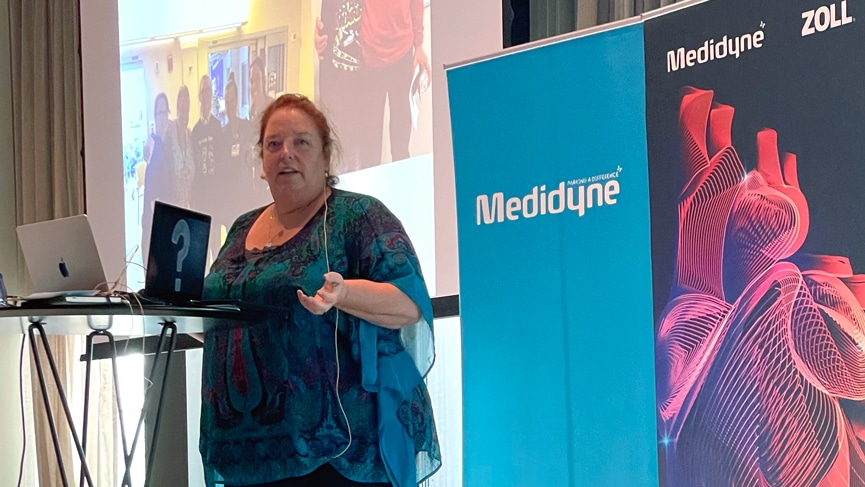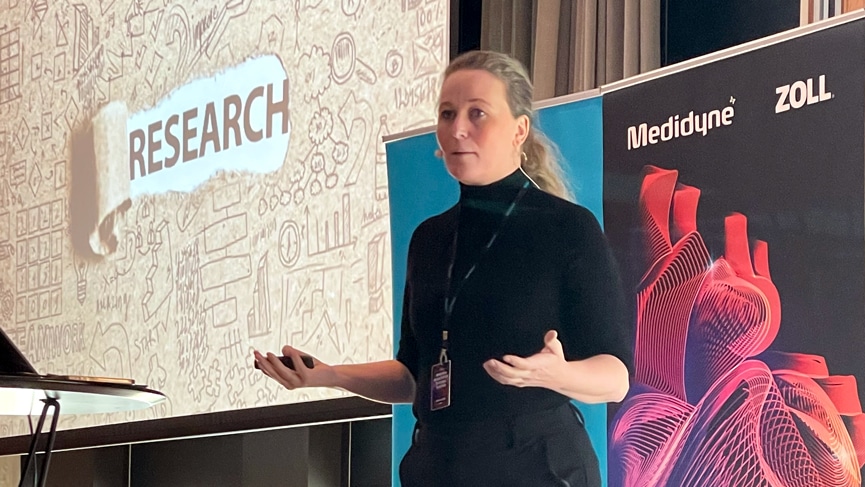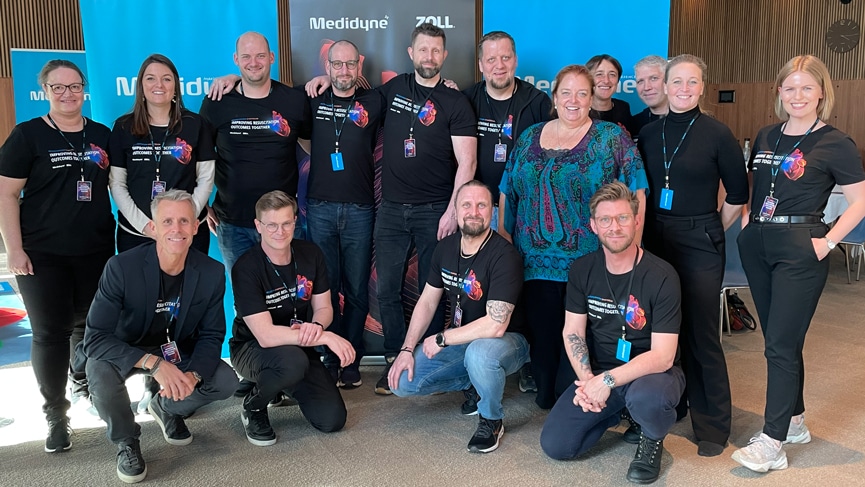March 23, 2023, we held Resuscitation Symposium in Copenhagen in collaboration with ZOLL. An event for paramedics and others working professionally with resuscitation. The theme was “improving resuscitation outcomes together” and placed great emphasis on debriefing as a tool for improvement. In this article we summarize the knowledge presented by the speakers to try and answer the question: What is a good debriefing after a cardiac arrest?
Before diving into the talks at the symposium, we will have a look at the concept of debriefing, and debriefing in the context of resuscitation.
What is debriefing?
A debriefing can be a very useful tool in many industries and situations e.g., business, military, and healthcare. The concept debriefing usually refers to a process of reflecting on an event or experience after it has taken place. It involves gathering the group of individuals who were involved in or affected by the event and engaging in a structured conversation about what happened, why it happened, and what could be done differently in the future. Typically, the goal is to learn from the experience, identify areas for improvement, and develop strategies for preventing issues from arising in the future.
Debriefing may involve asking questions, sharing observations and feedback, and brainstorming potential solutions or strategies. Benefits include increased awareness and understanding of the events that took place, improved communication and collaboration among team members, and identified actions that can lead to better outcomes in the future.

Martin Matzen and Karl Høeg
In this context, we are interested in the debriefing sessions held by healthcare professionals after performing resuscitation at a cardiac arrest. This is also referred to as post-resuscitation debriefing or post-cardiac arrest debriefing. Overall, there are two types of debriefing in this regard: hot debriefing and cold debriefing.
Hot debriefing
Hot debriefing is also known as immediate debriefing because it takes place immediately after the cardiac arrest has been managed. I.e., the team is gathered while the event is still fresh in everyone’s mind. The main purpose is to address any immediate concerns or issues that may have arisen during the resuscitation effort and to provide emotional support to the team members. The focus is often on discussing what happened and how the team responded but may also include discussions on making specific changes and improvements to the workflow.
Cold debriefing
Cold debriefing takes place after some time has passed since the cardiac arrest in question, e.g., a few days or few weeks later. The purpose of a cold debriefing session is typically to reflect on the event and to identify areas for improvement in processes or protocols and specific actions that can be taken to improve the team’s performance in future cases.
The main difference between hot and cold debriefing is the timing and focus of the debriefing sessions. Where hot debriefing is more focused on addressing immediate concerns and providing emotional support, cold debriefing is more focused on identifying specific areas for improvement. Hence, both types of debriefing can be valuable in helping the team to learn from the cardiac arrest and improve the quality of care for future patients.
Why is debriefing important?
Why do we even need to debrief? At Resuscitation Symposium, we started the day out with a most inspiring talk as a reminder why everyone was there: Stefan Jutterdal and Annmargreth Kvarnefors told the story of Stefan’s cardiac arrest on a biking trip on Bornholm in 2018.
When Stefan suffered a cardiac arrest, his wife Annmargreth performed CPR and got hold of a nearby AED with the assistance of people passing by. Now the couple is showing and telling their story to raise awareness of the need to learn how to perform CPR and the need for more publicly accessible AEDs, available 24/7. This includes meeting with politicians, collaborating with organizations who share their goals, starting a network for survivors and relatives in Sweden and more.

Stefan Jutterdal and Annmargreth Kvarnefors
Paramedics and other healthcare personnel involved in these encounters rarely get to meet with the survivors afterwards. Therefore, meeting Stefan and Annmargreth and hearing their story was very reaffirming. In the context of the symposium, it was great for setting the scene and highlighting that “improving resuscitation outcomes” means saving lives.
Improving resuscitation outcomes also means improving the quality of life for the survivors. Quality of life for survivors is a theme that was addressed by nurse and PhD Johan Israelsson in his talk “Health-related quality of life after cardiac arrest”.

Johan Israelsson
Johan made it a key point in his talk that we must provide support for both survivors and their relatives, in order for survivors of cardiac arrest to achieve a good quality of life. Relatives are important to support the survivor, and they can also suffer health issues after a cardiac arrest. We know little of the survivors of cardiac arrest and even less about the relatives. But what we do know, Johan stated, is that improving follow-up care is important for improving quality of life.
Hot debriefing – what should you be aware of?
Rasmus Meyer Lyngby, Paramedic and PhD, gave the talk “Hot debriefing and performance data – a novel approach” at Resuscitation Symposium.
Rasmus is doing research on how performing hot debriefings can improve resuscitation performance when attending out of hospital cardiac arrests (OHCA). In his talk, Rasmus shared some helpful guidance on challenges and ethical concerns to be aware of in relation to the hot debriefing.

Rasmus Meyer Lyngby
Before even getting started, you may consider when and where is a good place and time to debrief, especially if you are at someone’s home and there are relatives of the patient present. Time also matters in the way that it may be less effective to debrief in the middle of the night, as team members need to be able to take in information. Adding to this, you should be aware of keeping the debriefing short for several reasons: The shorter, the faster the team will be available for the next call, and if paramedics are already working overtime, debriefing adds to costs.
Rasmus also explained that there are some challenges that are hard to eliminate. First, teams change. This makes it difficult to carry on learnings from one cardiac arrest to the next. Adding to this, paramedics must wait until they can apply learnings from one cardiac arrest to the next, and paramedics only attend 1-3 cardiac arrests per year. So, the time from learning to applying the learning may be long.
When it comes to performing the debriefing, Rasmus uses the TALK framework to keep debriefings structured. The letters in TALK stand for target, analysis, learning and key points. Moreover, Rasmus has developed a field analysis tool for paramedics that helps them interpret data such as ECG.
Cold debriefing – how do you improve with data?
At Resuscitation Symposium, Elizabeth Hunt, Professor of Anesthesiology and Critical Care department, Johns Hopkins University School of Medicine, Baltimore, and Resuscitation Scientist, Johns Hopkins Hospital, Baltimore, did a talk about cold debriefing. The talk was called “Data-driven performance focused debriefing”.

Elizabeth Hunt
Elizabeth and her team perform a cold debriefing every week, same time and place, at which the past week’s cardiac arrests are evaluated. A key takeaway from Elizabeth’s talk is that data provides insights for debriefing that can help improve resuscitation, but that the insights become even more valuable when technology and humans work together.
We can collect a lot more data on resuscitation performance now than we could 15 years ago. Elizabeth’s team e.g., use data on depth and rate of compressions, time of defibrillation, pauses before and after defibrillation and more. Elizabeth explained that when a more data-driven approach was introduced there was some initial anxiety among team members. But as people realized that the data is numerical values and not about judging anyone personally, they started to actually ask to see it and learn from it.
However, Elizabeth explained, we still need the stories to complement the data. Data can e.g., show you pauses in resuscitation, but you cannot know the reason until you ask people. In continuation of this argument, Elizabeth also advised that you get curious in debriefing sessions and do not make assumptions. Otherwise, you risk misinterpreting data and jumping to the wrong conclusions. I.e., when used the right way, data can help improve the overall performance of the team and inspire everyone to do better.
The debriefing conversation
How do you perform the actual debriefing conversation? How do you start? How do you address issues? This and more was addressed by Sandra Viggers, MD Specialist Registrar Anaesthesia, in her talk at Resuscitation Symposium titled “Debriefing conversations – the start, the middle, and the end”.
Sandra started out with stating that a debriefing is a conversation about what happened, not a matter of pinpointing errors: The goal is to keep the focus on figuring out how to bring learnings to the next patient.

Sandra Viggers
For the one moderating the debriefing, Sandra had a lot of helpful advice on how to best manage the conversation. First, she suggested dividing the debriefing into three parts for structure: The beginning, the middle, and the end.
The beginning
Sandra put emphasis on the beginning, as the opening line matters a great deal when initiating the conversation: A great opening can help create a safe environment where focus is on improving patient care.
Small changes in wording will spark very different conversations: If you e.g., ask about feelings you may get a lengthier description from team members, whereas if you ask for a summary of actions you may get a brief, overall description of events.
A suggestion from Sandra in this regard, was to start out by asking for a one-minute summary from one person and tell that you will do a deep dive afterwards, to reassure everyone that there will be time for sharing feelings, frustrations and more. If you ask for emotions, make sure you have time and be aware that you might trigger emotions. Also, getting a summary may give you clues on what to discuss further in the middle part of the conversation. Overall, it was a piece of advice from Sandra that facilitators listen carefully to be able to ask the right questions.
The middle
The middle part of the debriefing is where the learning content is, Sandra explained. This is where all the w-questions should be asked. If there are goals identified prior to the debriefing, you can use them as a structure to guide the conversation.
Having an observational approach as facilitator may also be beneficial, Sandra explained: You can say “I observed X – can you tell me about it?” as an opening line for the middle part. Ask what, how, why and dig deeper into areas of improvement. But remember to also talk about what worked well, and you should do more of.
The end
How do you then close the conversation and transfer learning? Sandra explained that sometimes you may have very short time for closing, but it is important to prioritize the ending and summarize learnings. Otherwise, it is difficult to apply them and change behavior. So, in the ending, find out what people need to apply the learnings – maybe they need help, training, or something else. Then you can make actions points and formulate future practice and learning goals. As Sandra pointed out: If you must change behavior, you have to have a plan.
Conclusion – top tips for an effective debriefing
An effective debriefing session after a cardiac arrest can be very beneficial to the involved healthcare professionals as it may help them to reflect upon the event, learn from it, and improve the quality of care for future patients. Considering the above, how do you then perform a great debriefing? This is our six top tips for effective debriefing sessions after cardiac arrest.
1. Perform hot debriefing when possible
Perform hot debriefings immediately after attending a cardiac arrest to address any immediate concerns and evaluate the cardiac arrest while it is fresh in memory. Use a framework to keep the conversation structured and focused on learning.
2. Schedule a dedicated time for cold debriefing
Schedule a specific time and place for a cold debriefing session where everyone involved in e.g., the past week’s cardiac arrests can attend. Try and have everyone involved present, in order to gather different perspectives and insights.
3. Encourage open communication
When debriefing, focus on creating an environment where people feel comfortable sharing their thoughts, feelings, and concerns about the cardiac arrest. Encourage everyone to speak openly and listen actively to one another without judgment.
4. Use data for learning
Use data to enrich the debriefing session. It is e.g., nearly impossible for people to tell exactly how long a pause in compressions lasted and nearly impossible to tell from data why there was a long pause. But in combination, humans and data can provide enhanced insight into the resuscitation attempt that can be used for learning how to perform better.
5. Identify action items
Identify specific action items to address the areas for improvement that were identified during the debriefing session. Assign action items to individuals or groups and plan how they will be implemented.
6. Follow-up on action items
Last but not least, follow up on the action items during the next debriefing session to ensure that they were completed, and discuss any outcomes or results from the changes that were implemented.
If you would like to get more insight on the topic directly from the speakers at Resuscitation Symposium, listen to FOAMmedic’s podcast with interviews of all the speakers.

The organizing team and speakers






